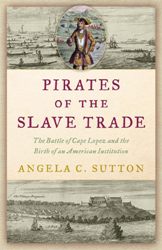 Pirates and Privateers Pirates and Privateers
The History of Maritime
Piracy
Cindy Vallar, Editor
& Reviewer
P.O. Box 425,
Keller, TX 76244-0425
    
Books for
Adults ~ History: Piracy

Pirates of the Slave Trade
The Battle of Cape Lopez and the Birth of an American
Institution
by Angela C. Sutton
Prometheus Books, 2023, ISBN 978-1-63388-844-9, US
$29.95
    
History is required in school, but during my youth
at least, my teachers didn’t always show how what
happened one place was connected with or impacted
events happening elsewhere. My research into pirates
and the past has taught me that these
interconnections do exist. More and more, books that
come across my desk strive to show this bigger,
often global picture. Pirates of the Slave Trade
is one such book.
At first glance, readers may wonder what was the
Battle of Cape Lopez. Those familiar with pirate
history know of it but more because of what happened
at this fight than by its name. It took place off
the coast of West Africa on 10 February 1722. The
outcome brought about the demise of one of the most
prolific pirates of the Golden Age of Piracy,
Bartholomew Roberts. The subsequent trials at Cape
Coast Castle led to mass hangings of fifty-two
pirates. Captain Chaloner Ogle of the British Royal
Navy would be honored with knighthood. Piracy began
to wane, whereas the buying and selling of slaves
increased in scope and intensity. In turn, this led
to changes in how Europeans viewed Africans and how
Britain and her colonies, especially in what would
become the United States, characterized those who
were enslaved.
This is, in essence, what Pirates of the Slave
Trade is about, but Sutton touches on many
peripheral topics related to piracy and slavery.
After setting the scene and introducing the main
characters, she examines what drew Roberts and his
men to Africa. He was neither a stranger to the
slave trade – his sailing career started aboard
slave ships – nor unknown when he returned to
African waters in 1722. (He was already a notorious
pirate, having captured more than 400 vessels and
murdered a governor.) Captain Ogle, on the other
hand, was a pirate hunter, a man determined to end
Roberts’s depredations and he possessed the
authority to do whatever it took to accomplish the
pirates’ eradication.
Sutton also introduces a third man to this equation:
John Conny, an Ahantan king who learned the ins and
outs of European slave trading operations firsthand
and used them to his advantage in what is now Ghana.
As he grew more influential and powerful, he
sheltered pirates and made it possible for them to
prey on ships of the various West India companies in
African waters.
The book is divided into two parts. “The Battle of
Cape Lopez” identifies principal players and
establishes the parameters that lead to the final
confrontation between the Royal Navy and the
pirates. “The Birth of an American Institution”
delves into the battle’s legacy, asking and seeking
answers to:
Who were
the real gentlemen of fortune here?
And who are they
today?
Who benefits
from global extraction-based exploitative
processes that change the face of the entire
world?
And who among us
(“us” meaning the national as well as the global
population) are left behind? (143-144)
Maps, artwork, and tables
accompany the narrative. Footnotes provide
additional information on topics mentioned in the
text, while endnotes provide citations to source
material consulted. There is an index, but no
bibliography.
Sutton deftly lays the groundwork on the slave trade
and slavery, piracy in Africa, and the people and
places involved to orient the reader in the primary
purpose of this book. She discusses the trading
companies to a fuller degree than is often covered
in history volumes. Readers gain a better
understanding of before and after, especially as
regards slavery in America. She skillfully shows how
one incident leads to another and another, showing
their interconnectedness and the resultant outcomes.
In addition, she utilizes the words and deeds of
William Snelgrave, a captain engaged in the slave
trade who also became a captive of three pirates, to
graphically depict the before and after changes.
Many authors writing books about pirates and their
connections to slavery tend to gloss over the
details, preferring to mention rather than
elucidate. Sutton dares to venture much further into
what is a provocative and sometimes incendiary
discussion; she does so “with an antiracist lens.”
(238) She explains why and lets readers know that
they can effect change – a fact that resonates
today. Pirates of the Slave Trade is
enlightening, thought-provoking, and a must read for
anyone who wants a fuller picture of the connections
between piracy, the slave trade, and the legacy the
downfall of one created for the other.
Review Copyright ©2023 Cindy Vallar

Click to contact me
Background image compliments
of Anke's Graphics |

